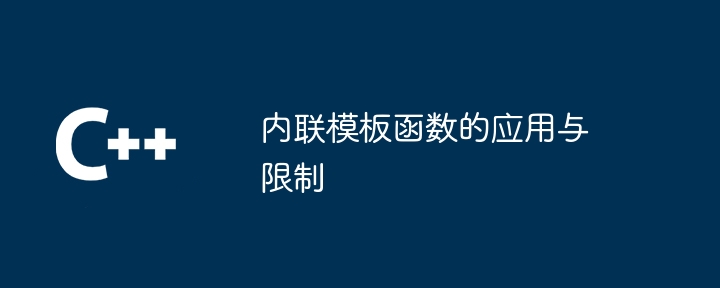Home >Backend Development >C++ >Applications and limitations of inline template functions
Applications and limitations of inline template functions
- 王林Original
- 2024-04-28 14:33:011107browse
Inline template functions insert code directly into the call point without generating a separate function object. Applications include code optimization, performance improvement, constant evaluation and code simplification. But be aware of its limitations, such as longer compilation times, increased code size, reduced debuggability, and limitations across compilation units.

Inline template function: application and limitations
Inline template function is a function code that is directly inserted at compile time Special function template for the call site. Unlike non-inline template functions, inline template functions do not generate a separate function object, which can reduce code size and overhead.
Application:
- Code Optimization: Eliminate virtual function calls and function pointer calls.
- Improve performance: Improve execution speed by avoiding the overhead of function calls, register saves and restores.
- Constant evaluation: When constants are used in the form of template parameters, inline template functions can insert the function code directly into the call site, allowing it to be evaluated at compile time.
- Code Simplification: Inline template functions can streamline code, making it easier to read and understand.
Limitations:
- Compilation time: Inline template functions may take longer to compile than non-inline template functions .
- Code size: Inline template functions can increase code size, especially for heavily used function templates.
- Debuggability: Inline template functions can be instantiated multiple times at the call site, which can make debugging difficult.
- Cross compilation units: Definitions of inline template functions must be fully contained in every compilation unit in which they are used.
Practical case:
Consider the following inline template function:
template<typename T>
inline T max(const T& a, const T& b) {
return (a > b) ? a : b;
}We can use this function as follows:
int a = 5; int b = 3; int max_value = max(a, b); // 调用内联模板函数
In this case, the function code return (a > b) ? a : b; will be at max_value = max(a, b); Union. This eliminates function call overhead and increases program execution speed.
Note: Inline template functions should be used with caution and their advantages and limitations should be fully considered. Excessive use of inline template functions can lead to longer compilation times and increased code size.
The above is the detailed content of Applications and limitations of inline template functions. For more information, please follow other related articles on the PHP Chinese website!
Related articles
See more- The system organizes the usage of Group By in SQL and the restrictions on multiple fields of Group By
- Optimization news for WeChat applet's 10 request concurrency limit! ! !
- How to set size limit for file upload using php
- How to limit the number of people using wifi?
- What should I do if the input content in Excel does not meet the restrictions?

